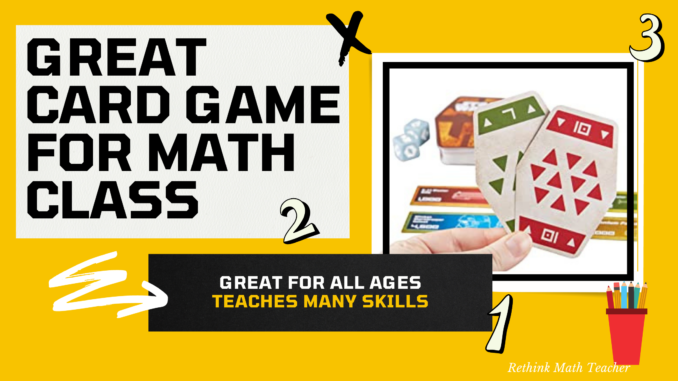
This post contains affiliate links
My children bought me this game for Christmas, and it is so great for teaching multiple math skills. It’s a wonderful activity for students of all ages.
Students work on addition and subtraction, absolute value, distance from zero, adding integers, and probability. My children are in second grade and they love playing it – even though adding integers isn’t learned for many years, they’ve already mastered it.
The game is Star Wars Hans Solo Card Game. And it’s based on a game we see Hans Solo playing in his stand-alone Star Wars origin movie, Solo. Here’s how it’s played.
How it’s Played
Each player is dealt two cards. Cards range from 0 to 9 and are either red or green colored. Red is negative and green is positive. The object is for your cards to combine to equal as close to zero as possible.
Each player gets three rounds. On your round you may pick up one card (but you don’t have to) from either the discard pile or the deck. And to end your turn, you may discard one card or none.
After all players have gone, and the round is over, the dealer rolls the two dice which have alien symbols on them. If the symbols match, all players must discard their cards and are dealt new ones (an element of chance).
Winners of the game pick from the available tokens – trying to get the Millennium Falcon. Tokens are different colors, and if one player is able to collect four of the red or blue tokens, they may steal the Millennium Falcon.
At the end of the game, all the tokens are added up, and the highest number wins.
Tie Breakers
The player whose cards total the lowest number wins. If the lowest number is obtained by two players, and one has the positive number and the other has the same absolute value, but it’s negative – the positive value breaks the tie. If both players have the same value (positive or negative) tie goes to the person who got that score with the most amount of cards.
What Students Learn
Multi-Digit Addition: Students must add the value of the tokens, and all tokens are in the thousands or ten thousands.
Simple Addition and Subtraction: For younger students, instead of saying that the red is negative and the green is positive, you can simply explain that you add numbers with the same color, and subtract numbers with opposite colors (and that green is better than red).
Adding Integers: For students old enough to work on integers, you explain that red cards are negative numbers and green cards are positive ones. As previously mentioned, my children are grades 2 and 3 and they were able to grasp the concept of integers because of this game. So this might even be a great way to introduce integers.
Absolute Value: The player whose score is the lowest absolute value is the winner. So this is a great way to introduce or reinforce this concept, as it is a great practical application.

How to Use in the Classroom
It may be difficult to purchase a class set. However, it is designed for 2-4 players. The reason they cap it at 4 players is that this allows the tokens to be distributed evenly. However, with some creativity with the tokens, you can have a few extra players.
Extension Activity: If you have students who work faster than their peers, you can easily allow them to play this game while their classmates continue working on their classwork.
Alternative to Remediation: If you have a group of students who have not mastered the skill and are remediating, you can allow those who don’t need the remediation to play this game as reinforcement.
Introducing New Concepts: This card game is a great way to introduce the concepts above. You can use the activity as a building block when you teach the mathematical concepts, drawing on the activity.
Part of your Math Stations: If you use math stations, this is a great one you can add to it. The game can be finished in under 10 minutes. However, even if the students at this station don’t finish it, they will still have fun during the time that they got to play it.
Response to Intervention: Do you have students who just can’t seem to grasp the concept that you’ve been teaching them? If it’s one that’s on the list above, you can have them play this game and then use it as a building block for the concepts you’re trying to get them to master.




